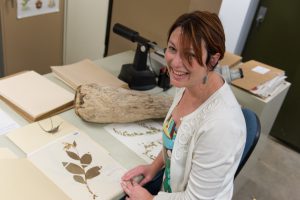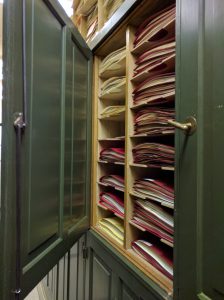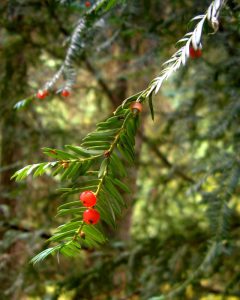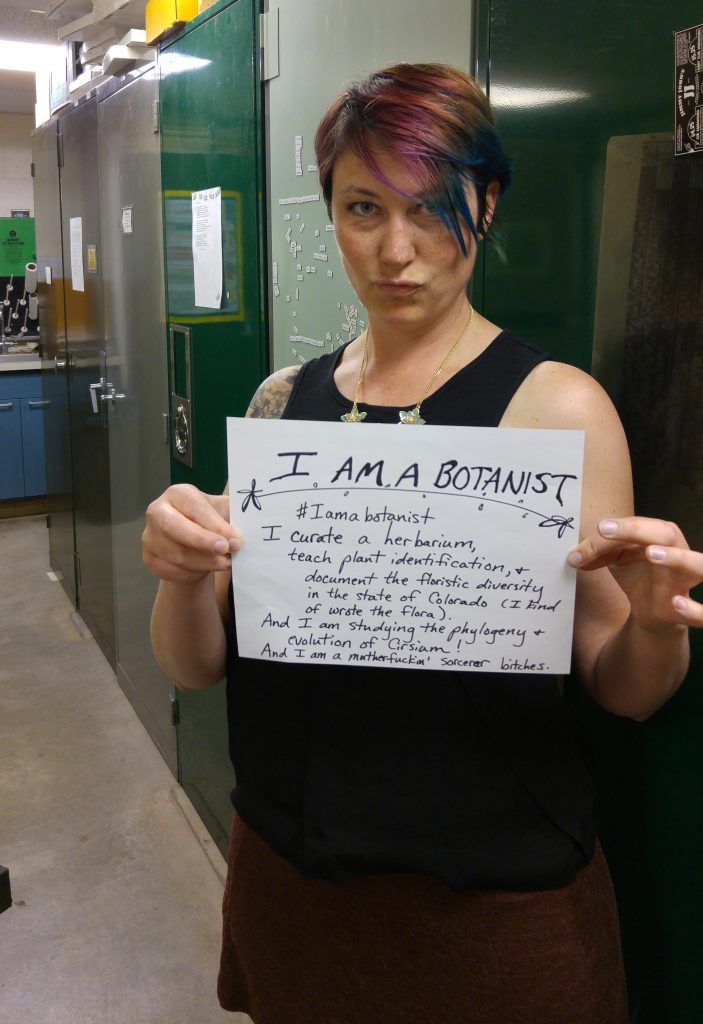
Guest post from Colorado State University Herbarium Collections Manager Jennifer Ackerfield. She literally wrote the book on Colorado flora.
Botany is not dead, but this plant is: The importance of herbaria in the 21st century and beyond
Herbarium. For many, this one word invokes images of a dark, dusty place, a mortuary for plants you might say. But for me, it invokes images of carefully examining plant specimens for taxonomic studies, lively scientific debate, group collaborative efforts to key out difficult plants, and students talking and working and most of all learning.
Learning about botany and collections and ultimately the importance of everything in a herbarium. Because a herbarium is so much more than a library of dusty plant specimens. It’s a repository of data, stretching back hundreds of years. Each time I pull out a herbarium specimen I think of all the work that a collector did to make that specimen – hiking, collecting, identifying, labeling, mounting, data basing, filing – so many hours go into the making of each herbarium specimen, and each one is lovingly cared for and stored in a herbarium. And ultimately, I think of each herbarium specimen as representing a moment in time. A permanent record of what was at that particular place at that particular time. And as moments in time, the data contained within each specimen is invaluable. Collectors hundreds of years ago could even not imagine what we are using herbarium specimens for now!
Herbarium specimens are more important than ever, providing documentation of the flora and evolutionary processes in our changing world (Wen et al., 2015; Buerki & Baker, 2016; McLean et al., 2016). Herbarium specimens are being used as never before to provide concrete, visual examples of global climate change, showing direct evidence that plants are flowering on average 16-35 days earlier now than 100 years ago (Primack et al., 2004; Willis et al., 2008; Panchen et al., 2012; Munson & Sher, 2015). Naysayers beware! Herbarium specimens have all the proof needed to show that climate change is real!

Herbarium specimens are also being used as never before to provide material for DNA sequencing – our advances in technology enable botanists now to extract DNA from older and older material, allowing us to fill in gaps where collecting specimens is not feasible or where the plants themselves have even become extinct (Pyron, 2015; Zedane et al., 2016). The ability to exclusively use herbarium specimens to conduct taxonomic studies and reconstruct evolutionary histories of plants is also rapidly enhancing our knowledge of many large, taxonomically difficult genera. We are able now to utilize sequencing methods that are enabling botanists to resolve the lineages of groups that have previously had low resolution in phylogenetic trees by providing a larger data set of molecular characters, entire genomes even!
Evolution is a change in allele frequency in a population over time, resulting in heritable change among successive generations. And what better record of these changes in allele frequency over time than with the data held in the DNA of herbarium specimens! Our ability to sequence large genomic sets of data from older and older herbarium specimens lends evidence for these changes in allele frequency over time, providing a window into evolutionary processes (Pyke & Ehrlich, 2010). Studies using herbarium specimens have recently revealed dramatic examples of morphological and phenotypic change over relatively short time scales in response to strong selective pressures. Herbarium specimens have been used to show that rapid genetic adaptation often precedes the spread of invasive species and probably assists in overcoming environmental constraints that may have otherwise kept these species from rapidly spreading (Martin et al., 2014; Vandepitte et al., 2014), providing valuable insight into the spread of noxious plants.
Herbarium specimens have also been used to track the spread of plant pathogens and invasive insects. Herbarium samples were used to reconstruct the 19th century potato blight pandemic (Yoshida et al., 2015) as well as elucidate the origin of the horse chestnut leaf-mining moth (Lees et al., 2011). Herbarium specimens are invaluable records for investigating distributional patterns of species as well as species migrations, and the expansions or contractions of plants distributions (Feeley, 2012; Wolkovich et al., 2013; Dormontt et al., 2014).
One of the more recent uses of herbarium specimens has been to use these points of data to compile phylogenetic community assemblages (Gonzalez-Orozco et al., 2016; Thornhill et al., 2016). These assemblages identify areas with the greatest amount of phylogenetic diversity, or in other words areas with species that are more distantly related than others and thus evolutionarily significant regions of diversity. These studies help analyze how evolutionary relationships have affected trait evolution, predict how and where the ranges of plants will expand or shrink in response to climate change, identify areas that will become refuges as climate conditions change, and can ultimately be used to identify areas of immediate conservation concern.
And resting at the backbone of each and every one of these studies, new advances, and new discoveries are herbarium specimens. Those dusty specimens of dead plants. And of course ultimately, each and every phylogenetic study made using these herbarium specimens goes into our greater understanding of the Tree of Life, an evolutionary tree showing the relationships among 2.3 million living species on Earth. Earlier this summer I was in a particularly philosophical mood. I couldn’t stop thinking about the interconnectedness of life all around us. As botanists, it is our role to categorize, document, and explain this interconnectedness. And in this philosophical mood, I watched botanist

Doug Soltis talk about the Tree of Life. I wasn’t expecting it, but watching him talk brought tears to my eyes. Why? Isn’t it just a big phylogeny, a giant tree? Why would it make a person (even a botanist) get teary-eyed? Well, because it means that botany matters. That what we do matters. Even more so, the potential life-saving plants out there yet undiscovered, and the ones already put into use that have saved countless lives wouldn’t be here if it weren’t for botanists. And the one example that Soltis used hit home in a big way – taxol from the Pacific Yew. You see, I wouldn’t be here myself if it wasn’t for taxol. If it weren’t for botanists. And of course if it weren’t for the Pacific Yew. You see, 4 years ago I was taking weekly infusions of taxol to combat cancer. I owe my life to a plant. And as a botanist, that’s coming full circle in a pretty big way. The interconnectedness of life is all around us, all the time.
Sadly, the future of herbaria and the herbarium specimens that they hold is rather bleak. Herbaria and museums are often one of the first places universities look to cut funding when faced with budget crises. The conception of herbaria as dark, dusty places storing dead plants needs to change. Herbaria are places conducting active research, and important components to a university and community. Herbaria provide a space for students to learn about botany. They provide a space for school groups to tour, for kids to become excited about plants. Botanists at herbaria actively engage in public outreach by leading workshops, seminars, and field trips. So, while the specimens in herbaria may be “dead”, herbaria themselves are not. Every specimen in a herbarium holds a story. And herbarium specimens are being used as never before to document our changing world and elucidate evolutionary processes and relationships. Protecting and caring for these invaluable and irreplaceable resources must be at the forefront for universities, botanic gardens, and museums. Because only time will tell what herbarium specimens will be used for in the future, as permanent records of the past.

Buerki, S., & Baker, W. (2016). Collections-based research in the genomic era Biological Journal of the Linnean Society, 117 (1), 5-10 DOI: 10.1111/bij.12721
Dormontt, E., Gardner, M., Breed, M., Rodger, J., Prentis, P., & Lowe, A. (2014). Genetic Bottlenecks in Time and Space: Reconstructing Invasions from Contemporary and Historical Collections PLoS ONE, 9 (9) DOI: 10.1371/journal.pone.0106874
Feeley, K. (2012). Distributional migrations, expansions, and contractions of tropical plant species as revealed in dated herbarium records Global Change Biology, 18 (4), 1335-1341 DOI: 10.1111/j.1365-2486.2011.02602.x
González-Orozco, C., Pollock, L., Thornhill, A., Mishler, B., Knerr, N., Laffan, S., Miller, J., Rosauer, D., Faith, D., Nipperess, D., Kujala, H., Linke, S., Butt, N., Külheim, C., Crisp, M., & Gruber, B. (2016). Phylogenetic approaches reveal biodiversity threats under climate change Nature Climate Change DOI: 10.1038/nclimate3126
Lees, D., Lack, H., Rougerie, R., Hernandez-Lopez, A., Raus, T., Avtzis, N., Augustin, S., & Lopez-Vaamonde, C. (2011). Tracking origins of invasive herbivores through herbaria and archival DNA: the case of the horse-chestnut leaf miner Frontiers in Ecology and the Environment, 9 (6), 322-328 DOI: 10.1890/100098
Martin, M., Zimmer, E., Olsen, M., Foote, A., Gilbert, M., & Brush, G. (2014). Herbarium specimens reveal a historical shift in phylogeographic structure of common ragweed during native range disturbance Molecular Ecology, 23 (7), 1701-1716 DOI: 10.1111/mec.12675
McLean, B., Bell, K., Dunnum, J., Abrahamson, B., Colella, J., Deardorff, E., Weber, J., Jones, A., Salazar-Miralles, F., & Cook, J. (2016). Natural history collections-based research: progress, promise, and best practices Journal of Mammalogy, 97 (1), 287-297 DOI: 10.1093/jmammal/gyv178
Munson, S., & Sher, A. (2015). Long-term shifts in the phenology of rare and endemic Rocky Mountain plants American Journal of Botany, 102 (8), 1268-1276 DOI: 10.3732/ajb.1500156
Panchen, Z., Primack, R., Anisko, T., & Lyons, R. (2012). Herbarium specimens, photographs, and field observations show Philadelphia area plants are responding to climate change American Journal of Botany, 99 (4), 751-756 DOI: 10.3732/ajb.1100198
Primack, D., Imbres, C., Primack, R., Miller-Rushing, A., & Del Tredici, P. (2004). Herbarium specimens demonstrate earlier flowering times in response to warming in Boston American Journal of Botany, 91 (8), 1260-1264 DOI: 10.3732/ajb.91.8.1260
Pyke, G., & Ehrlich, P. (2010). Biological collections and ecological/environmental research: a review, some observations and a look to the future Biological Reviews, 85 (2), 247-266 DOI: 10.1111/j.1469-185X.2009.00098.x
Pyron, R.A., 2015. Post-molecular systematics and the future of phylogenetics. Trends in Ecology and Evolution, 30(7), pp.384–389.
Thornhill, A., Mishler, B., Knerr, N., González-Orozco, C., Costion, C., Crayn, D., Laffan, S., & Miller, J. (2016). Continental-scale spatial phylogenetics of Australian angiosperms provides insights into ecology, evolution and conservation Journal of Biogeography DOI: 10.1111/jbi.12797
Vandepitte, K., de Meyer, T., Helsen, K., van Acker, K., Roldán-Ruiz, I., Mergeay, J., & Honnay, O. (2014). Rapid genetic adaptation precedes the spread of an exotic plant species Molecular Ecology, 23 (9), 2157-2164 DOI: 10.1111/mec.12683
Wen, J., Ickert-Bond, S., Appelhans, M., Dorr, L., & Funk, V. (2015). Collections-based systematics: Opportunities and outlook for 2050 Journal of Systematics and Evolution, 53 (6), 477-488 DOI: 10.1111/jse.12181
Willis, C., Ruhfel, B., Primack, R., Miller-Rushing, A., & Davis, C. (2008). Phylogenetic patterns of species loss in Thoreau’s woods are driven by climate change Proceedings of the National Academy of Sciences, 105 (44), 17029-17033 DOI: 10.1073/pnas.0806446105
Wolkovich, E., Davies, T., Schaefer, H., Cleland, E., Cook, B., Travers, S., Willis, C., & Davis, C. (2013). Temperature-dependent shifts in phenology contribute to the success of exotic species with climate change American Journal of Botany, 100 (7), 1407-1421 DOI: 10.3732/ajb.1200478
Yoshida, K., Sasaki, E., & Kamoun, S. (2015). Computational analyses of ancient pathogen DNA from herbarium samples: challenges and prospects Frontiers in Plant Science, 6 DOI: 10.3389/fpls.2015.00771
Zedane, L., Hong-Wa, C., Murienne, J., Jeziorski, C., Baldwin, B., & Besnard, G. (2016). Museomics illuminate the history of an extinct, paleoendemic plant lineage (, Oleaceae) known from an 1875 collection from Guadalupe Island, Mexico Biological Journal of the Linnean Society, 117 (1), 44-57 DOI: 10.1111/bij.12509
